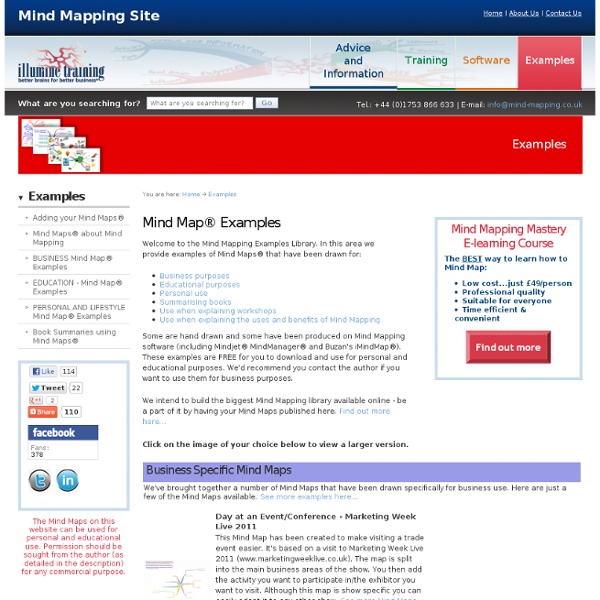MindMapping
Mind Map
From Wikipedia, the free encyclopedia Diagram to visually organize information A mind map is a diagram used to visually organize information into a hierarchy, showing relationships among pieces of the whole.[1] It is often created around a single concept, drawn as an image in the center of a blank page, to which associated representations of ideas such as images, words and parts of words are added. Major ideas are connected directly to the central concept, and other ideas branch out from those major ideas. Mind maps can also be drawn by hand, either as "notes" during a lecture, meeting or planning session, for example, or as higher quality pictures when more time is available. Origins[edit] Buzan's specific approach, and the introduction of the term "mind map", started with a 1974 BBC TV series he hosted, called Use Your Head.[6] In this show, and companion book series, Buzan promoted his conception of radial tree, diagramming key words in a colorful, radiant, tree-like structure.[7]
La pensée latérale et les pièges de l’intelligence selon Edward de Bono : post-athéisme
Réfléchir est la technique opératoire avec laquelle l’intelligence exploite l’expérience. Expert de la créativité, docteur en médecine et philosophie, Edward de Bono a enseigné à Harvard et conseille des dirigeants d’entreprises et responsables politiques. Auteur de plusieurs best-sellers mondiaux, il explique dans Réfléchir vite et bien les processus fondamentaux de la réflexion quelque soit le domaine d’application. “Une personne très intelligente peut avoir un point de vue sur un sujet et utiliser ensuite son intelligence pour défendre ce point de vue. Vous êtes persuadé de connaître la Vérité ? La pensée latérale est un concept remarquable. L’auteur continue : “Le second aspect du piège de l’intelligence est que, si une personne a grandi avec la certitude qu’elle est plus intelligente que la moyenne (ce qui peut être effectivement le cas), elle voudra jouir de cette faculté. L’exlectique est une alternative à la dialectique. Réfléchir vite et bien
KMRC
Knowledge acquisition, knowledge exchange, and knowledge communication using innovative technologies form the core of the research topics at the Knowledge Media Research Center in Tuebingen. Our researchers are concerned with classic forms of teaching and education in schools and higher education, as well as with promoting learning in informal settings, such as in museums, the internet, and the work place. At the KMRC, our multidisciplinary team of highly trained scientists from cognitive and educational sciences, human behavioral sciences, and social sciences works closely with experts from media technology and computer science. On our website you will find further insights into our organizational structure and the research conducted at the institute. Director of the kmrc with a talk at the Beijing Forum This year marks the tenth anniversary of Beijing Forum (Peking, China), which is scheduled on November 1st-3rd 2013.
BrainMap
Inspiration Mind Maps 1-9
The Inspiration Mind Maps 1-9 above are also available as a Free E-Book
Power Mapping
I was thrilled to learn that Jamie Nast’s book “Idea Mapping” was translated into Russian. OZON.ru, one of the most popular online booksellers in Russia that is using business model similar to Amazon.com (they even sound similar, or almost similar, don’t you think?), posted a customer review that I thought had failed to do the book justice. Книга очень полезная. Я ознакомилась с русским переводом книги после прочтения оригинального издания и мне кажется, что, не смотря на хороший перевод и соответствие оригиналу, не всё поддаётся дословному переводу. Визуализация мыслей и идей с помощью схем и карт не является достижением нашей эпохи, уходя корнями в историю. Особенность ментальных карт заключается в том, что они отражают естественную работу мозга, в частности его ассоциативную природу. Книга преподносит материал с элегантной простотой, что нельзя путать с упрощённостью, используя многочислкнные примеры и иллюстрации.
FreeMind
« Petite philosophie des grandes trouvailles » Luc de Brabandère.
« Petite philosophie des grandes trouvailles » Luc de Brabandère. Eyrolles. 2010 . 13,30 € Peut-être avez-vous omis de lire ce livre de Luc de Brabandère pressés par vos occupations de cadres overtime . C’est grand dommage car ce livre présente deux avantages : il est court (130 pages) et il apporte une fulgurance de plaisir intellectuel comme ces bonbons à la menthe qui vous embrasent de fraîcheur, si je puis me permettre cet oxymore. Il nous parle de philosophie et de « trouvailles » et déjà sans avoir besoin de tout lire vous êtes récompensé dés la couverture. Philosophie, voila bien ce qui nous manque, emporté par le mouvement brownien de nos occupations futiles. De plus, le fait d’employer le mot « trouvaille » est une trouvaille (je répète par plaisir) qui me donne un bonheur intense comme une averse de fraîcheur sur une peau brûlée de chaleur. Résumons-nous : la créativité est une aptitude individuelle, comme l’agilité, la dextérité, la vélocité.



